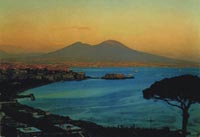Study Shows Massive Magma Chamber Lies Beneath Vesuvius

Image: Courtesy of Paolo Gasparini
Mount Vesuvius, the volcano most famous for blanketing the towns of Pompei and Herculaneum with lava and debris in 79 A.D., may be sitting atop a reservoir of magma that covers more than 400 square kilometers, a new study suggests. The finding, reported in the current issue of the journal Science by a group of Italian and French scientists, may lead to more accurate monitoring of the area surrounding the volcano.
Building on previous work that suggested the presence of a magma zone underneath Vesuvius, Emmanuel Auger of the Università di Napoli Federico II in Naples, Italy and colleagues employed seismic tomography to estimate its size. The scientists produced seismic waves and traced their paths through the zone beneath Vesuvius. Using the speed and direction of the waves, they compiled an image of the crust under the volcano. The picture that emerged, the researchers report, includes a magma reservoir buried eight kilometers deep in the earth’s crust that is at least 400 square kilometers wide. “This also tells us that there is a huge amount of available magma under Vesuvius,” co-author Paolo Gasparini says. “It was really unexpected for the reservoir to be that size, so very wide and large.”
A better understanding of the reservoir’s structure, location and volume, the authors write, “can be used to help prediction of the scenario of the next eruption and to interpret the pattern of the expected precursory seismic activity and ground deformation.” Unfortunately for the region’s inhabitants however, it can’t help predict when the next eruption will occur.
Media Contact
More Information:
http://www.sciam.com/news/111901/1.htmlAll latest news from the category: Earth Sciences
Earth Sciences (also referred to as Geosciences), which deals with basic issues surrounding our planet, plays a vital role in the area of energy and raw materials supply.
Earth Sciences comprises subjects such as geology, geography, geological informatics, paleontology, mineralogy, petrography, crystallography, geophysics, geodesy, glaciology, cartography, photogrammetry, meteorology and seismology, early-warning systems, earthquake research and polar research.
Newest articles

First-of-its-kind study uses remote sensing to monitor plastic debris in rivers and lakes
Remote sensing creates a cost-effective solution to monitoring plastic pollution. A first-of-its-kind study from researchers at the University of Minnesota Twin Cities shows how remote sensing can help monitor and…

Laser-based artificial neuron mimics nerve cell functions at lightning speed
With a processing speed a billion times faster than nature, chip-based laser neuron could help advance AI tasks such as pattern recognition and sequence prediction. Researchers have developed a laser-based…

Optimising the processing of plastic waste
Just one look in the yellow bin reveals a colourful jumble of different types of plastic. However, the purer and more uniform plastic waste is, the easier it is to…



